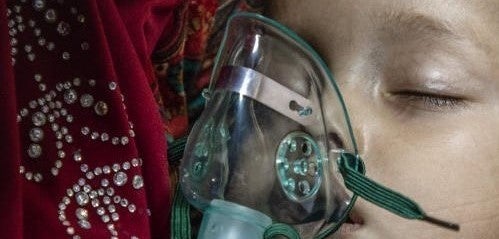 Laila*, holds an oxygen mask to the face of her son, Sohai*, two, at Save the Children's primary healthcare centre (PHCC) in Cox's Bazaar, Bangladesh.
Laila*, holds an oxygen mask to the face of her son, Sohai*, two, at Save the Children's primary healthcare centre (PHCC) in Cox's Bazaar, Bangladesh.
In his first interview after leaving the hospital treating him for COVID-19 (coronavirus), UK Prime Minister Boris Johnson recounted the desperate moments when his life hung in the balance. “I was going through liters and liters of oxygen,” he recalled, adding about his recovery: “I was a very lucky man.”
It was a comment that highlighted the critical importance of medical oxygen. Without it, the Prime Minister’s brush with COVID-19 might have had a tragically different ending.
Oxygen is all around us in the air we breathe. Perhaps that’s why we sometimes forget it is also a life-saving essential medicine. Medical oxygen is a key treatment for severe pneumonia, malaria, sepsis and meningitis. Yet it is seldom available to the children and mothers whose lives are at risk. Where it is available, it is often unaffordable to the poorest and most disadvantaged.
Media coverage of the COVID-19 pandemic has created a moral panic over shortages of ventilators available in Africa. Those shortages are real. But increasing the stock of ventilators without fixing oxygen systems is a prescription for avoidable fatalities. Medical oxygen is the primary treatment for the majority of patients who are suffering severe COVID-19 symptoms. That’s why the WHO recommends that all countries focus on the development of medical oxygen systems and provision of pulse oximeters to measure blood oxygen levels.
Following that advice will help build a more equitable health system, one that’s equipped to respond not only to the viral pneumonia threatening adults with COVID-19, but also to the viral and bacterial pneumonia that is now the biggest infectious killer of children. This is a disease that claims over 800,000 young lives every year. Never mind ventilators: many of these children are left fighting for breath without even the most basic oxygen therapy. Yet as the Every Breath Counts Coalition points out, the COVID-19 response so far has largely overlooked the importance of medical oxygen supply and diagnostic tools for identifying hypoxemia.
Last year I visited rural health clinics and hospitals across northwest Nigeria, an area marked by endemic malnutrition, childhood pneumonia and malaria. Medical oxygen was almost entirely absent from health facilities. Doctors in one referral hospital told me they were regularly forced to ration access to oxygen between children in desperate need, based on judgments about their survival prospects. And this is a microcosm of experience across the poorest countries. Modeling suggests that improving oxygen access could avert 148,000 deaths of children under 5 each year in the 15 countries that have the highest pneumonia burden. So why are we losing so many lives that could be saved?
Medical oxygen supplies starkly illustrate health inequalities between and within countries. The UK hospital that treated Boris Johnson for COVID-19 is supplied with industrial quantities of high-grade liquid oxygen, with storage facilities linked to patients through miles of piping and complex valves. Bulk purchases reduce costs. Meanwhile, public financing of the National Health Service means patients receive oxygen free of charge.
Contrast this with the situation in poorer countries. Most hospitals are supplied by cylinders filled at industrial gas plants and transported by truck. Patients are typically charged directly for the cost of refilling. Treating a child with severe pneumonia over 3-4 days can require anything from 4,000 to 8,000 cubic liters of oxygen at a cost of $40-60. For the poorest households, that prospective bill represents a huge barrier to treatment – if the child is able to get to a hospital with oxygen at all.
The challenge is to increase the supply of medical oxygen while reducing cost so that it’s accessible where it’s needed most, free at the point of use. It will take increased investment and commitment to put oxygen at the center of strategies for universal health coverage.
Market management can help. Pooling demand can help generate economies of scale and drive down prices. In Kenya, a social enterprise, Hewa Tele, has established three oxygen production plants, each serving a cluster of hospitals. The plants have cut hospital purchase costs by around one-third.
Similar models are being developed in other countries. In Ethiopia, a coalition of companies, philanthropic foundations, UN agencies, and not-for-profit actors – the United4Oxygen Alliance – is working with the government to implement Africa's first national plan for universal access to medical oxygen.
The opportunities are vast, but innovation is needed to reach the most vulnerable. One initiative – FREO2 – has developed ingenious technologies to concentrate and store oxygen in health centers that lack electricity. Investing in the maintenance of concentrators and adapting them for use across 4-5 children through simple plastic tubing is another low-tech solution that can save lives.
Medical oxygen has been recognized as an essential medicine for well over a century. Yet it remains beyond the reach of desperately vulnerable children. It has not figured in the priorities of the global development organizations. There are no major global campaigns or disease days to galvanize action on medical oxygen, despite the suffering caused by its absence of supply. The fact that the poorest and most disadvantaged children bear the brunt of the medical oxygen deficit adds to the urgency for action.
COVID-19 is a public health crisis without parallel in recent history. But it is also an opportunity to turn the spotlight on medical oxygen as one of the defining health equity issues of our age. Universal access to oxygen is not a vague aspiration. We lack neither the finance nor the technology. The need is self-evident. What has been missing is political leadership and international cooperation – and those are deficits we can fix.
Save the Children is a member of the Every Breath Counts Coalition, who alongside with partners organized the world’s first Global Forum on Childhood Pneumonia earlier this year.


Join the Conversation